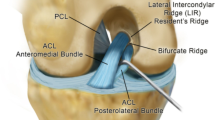Abstract
The posterior cruciate ligament is one of the most controversial issues in sports medicine. There is no consensus in the literature with respect to its incidence, natural history, and treatment indications. Injury evaluation is often underestimated, with the result of misdiagnosed injury or wrong treatment. This contribution reviews the principles of diagnostic evaluation of posterior cruciate ligament injuries.






Similar content being viewed by others
References
Chassaing V, Deltour F, Touzard R, Ceccaldi JP, Miremad C (1995) Etude radiologique du L.C.P. à 90 de flexion. Rev Chir Orthop Reparatrice Appar Mot 81:35–38
Daniel DM, Stone ML, Barnett P, Sachs R (1988) Use of the quadriceps active test to diagnose posterior cruciate—ligament disruption and measure posterior laxity of the knee. J Bone Joint Surg Am 70:386–391
Escobedo EM, Mills WJ, Hunter JC (2002) The "reverse Segond" fracture: association with a tear of the posterior cruciate ligament and medial meniscus. AJR Am J Roentgenol 178:979–983
Fanelli GC, Edson CJ (1995) Posterior cruciate ligament injuries in trauma patients. II. Arthroscopy 11:526–529
Fowler PJ, Messieh SS (1987) Isolated posterior cruciate ligament injuries in athletes. Am J Sports Med 15:553–557
Gross ML, Grover JS, Bassett LW, Seeger LL, Finerman GA (1992) Magnetic resonance imaging of the posterior cruciate ligament. Clinical use to improve diagnostic accuracy. Am J Sports Med 20:732–737
Hall G, Hochman MG (1997) Medial Segond-type fracture: cortical avulsion off the medial tibial plateau associated with tears of the posterior cruciate ligament and medial meniscus. Skeletal Radiol 26:553–555
Hewett TE, Noyes FR, Lee MD (1997) Diagnosis of complete and partial posterior cruciate ligament ruptures. Stress radiography compared with KT-1000 arthrometer and posterior drawer testing. Am J Sports Med 25:648–655
Huber FE, Irrgang JJ, Harner C, Lephart S (1997) Intratester and intertester reliability of the KT-1000 arthrometer in the assessment of posterior laxity of the knee. Am J Sports Med 25:479–485
Jacobsen K (1977) Stress radiographical measurements of post-traumatic knee instability. A clinical study. Acta Orthop Scand 48:301–310
Margheritini F, Mariani PP, Christel P, Chambat PB, Bellelli A, Mancini L (2001) How does the posterior cruciate ligament heal? A prospective multicentric MRI study with functional implications. Arthroscopy 17, abstract
Margheritini F, Mancini L, Mauro C, Mariani PP (2003) Stress radiographies for quantifying posterior cruciate ligament deficiency. Arthroscopy 19:706–711
Mariani PP, Adriani E (1994) Teilruptur des hinteren Kreuzbands mit isoliertem Ausriß der femoralen insertion. Arthroskopie 7:131–132
Miyasaka KC, Daniel DM, Stone ML (1991) The incidence of knee ligament injuries in the general population. Am J Knee Surg 4:3–8
Osti L, Bartelett J (2001) The value of the kneeling view to evaluate the posterior knee instability. In: International PCL Study Group Meeting, Kurumba
Parolie JM, Bergfeld JA (1986) Long-term results of nonoperative treatment of isolated posterior cruciate ligament injuries in the athlete. Am J Sports Med 14:35–38
Puddu G, Gianni E, Chambat P, De Paulis F (2000) The axial view in evaluating tibial translation in cases of insufficiency of the posterior cruciate ligament. Arthroscopy 16:217–220
Rubinstein RA Jr, Shelbourne KD, McCarroll JR, VanMeter CD, Rettig AC (1994) The accuracy of the clinical examination in the setting of posterior cruciate ligament injuries. Am J Sports Med 22:550–557
Shelbourne KD, Benedict F, McCarrol J, Rettig AC (1989) Dynamic posterior shift test. Am J Sports Med 17:275–277
Shelbourne KD, Jennings RW, Vahey TN (1999) Magnetic resonance imaging of posterior cruciate ligament injuries: assessment of healing. Am J Knee Surg 12:209–213
Shino K, Mitsuoka T, Horibe S, Hamada M, Nakata K, Nakamura N (2000) The gravity sag view: a simple radiographic technique to show posterior laxity of the knee. Arthroscopy 16:670–672
Skyhar MJ, Warren RF, Ortiz GJ, Schwartz E, Otis JC (1993) The effects of sectioning of the posterior cruciate ligament and the posterolateral complex on the articular contact pressures within the knee. J Bone Joint Surg Am 75:694–699
Stäubli HU, Jakob RP (1990) Posterior instability of the knee near extension. A clinical and stress radiographic analysis of acute injuries of the posterior cruciate ligament. J Bone Joint Surg Br 72:225–230
Stäubli HU, Noesberger B, Jakob RP (1992) Stressradiography of the knee. Cruciate ligament function studied in 138 patients. Acta Orthop Scand Suppl 249:1–27
Strobel M (1999) PCL reconstructions. In: PCL Study Group International, Cape Town
Strobel MJ, Weiler A, Schulz MS, Russe K, Eichhorn HJ (2002) Fixed posterior subluxation in posterior cruciate ligament-deficient knees: diagnosis and treatment of a new clinical sign. Am J Sports Med 30:32–38
Tewes DP, Fritts HM, Fields RD, Quick DC, Buss DD (1997) Chronically injured posterior cruciate ligament: magnetic resonance imaging. Clin Orthop 224–232
Whipple TL, Ellis FD (1991) Posterior cruciate ligament injuries. Clin Sports Med 515–557
Wirz P, von Stokar P, Jakob RP (2000) The effect of knee position on the reproducibility of measurements taken from stress films: a comparison of four measurement methods. Knee Surg Sports Traumatol Arthrosc 8:143–148
Author information
Authors and Affiliations
Corresponding author
Rights and permissions
About this article
Cite this article
Margheritini, F., Mariani, P.P. Diagnostic evaluation of posterior cruciate ligament injuries. Knee Surg Sports Traumatol Arthrosc 11, 282–288 (2003). https://doi.org/10.1007/s00167-003-0409-0
Received:
Accepted:
Published:
Issue Date:
DOI: https://doi.org/10.1007/s00167-003-0409-0




